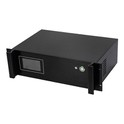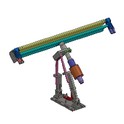Hey there! As a supplier of 1000w ultrasonic generators, I've seen firsthand how these powerful machines can make a real difference in various industries. But like any piece of equipment, they need proper maintenance to keep them running smoothly and efficiently. In this blog post, I'll share some tips on how to maintain a 1000w ultrasonic generator, based on my experience in the field.
Understanding Your 1000w Ultrasonic Generator
Before we dive into maintenance tips, let's quickly go over what a 1000w ultrasonic generator is and how it works. Simply put, an ultrasonic generator is a device that converts electrical energy into high-frequency ultrasonic waves. These waves are then used for a variety of applications, such as cleaning, welding, and cutting.
A 1000w ultrasonic generator is a relatively high-powered unit that can handle more demanding tasks. It typically consists of a power supply, a control circuit, and a transducer. The power supply provides the electrical energy, the control circuit regulates the output, and the transducer converts the electrical energy into ultrasonic waves.
Regular Cleaning
One of the most important aspects of maintaining a 1000w ultrasonic generator is regular cleaning. Over time, dust, dirt, and debris can accumulate on the generator's components, which can affect its performance and lifespan. To prevent this, it's a good idea to clean the generator at least once a month.
Start by unplugging the generator from the power source to avoid any electrical hazards. Then, use a soft, dry cloth to wipe down the exterior of the generator, removing any dust or dirt. Pay special attention to the ventilation openings, as these can become clogged with debris, which can cause the generator to overheat.
Next, use a compressed air canister to blow out any dust or debris from the interior of the generator. Be careful not to get too close to the components, as this can damage them. You can also use a small brush to gently clean the hard-to-reach areas.


Inspecting the Components
In addition to regular cleaning, it's also important to inspect the generator's components on a regular basis. This can help you identify any potential problems before they become serious and cause the generator to malfunction.
Start by checking the power supply for any signs of damage, such as frayed wires or loose connections. If you notice any issues, it's important to have them repaired or replaced as soon as possible.
Next, inspect the control circuit for any signs of damage or wear. Look for any loose connections, burned-out components, or signs of corrosion. If you notice any issues, it's best to have a professional technician inspect and repair the circuit.
Finally, check the transducer for any signs of damage or wear. Look for any cracks, chips, or other damage to the transducer's surface. If you notice any issues, it's important to have the transducer replaced as soon as possible, as a damaged transducer can affect the generator's performance and lifespan.
Checking the Cooling System
Another important aspect of maintaining a 1000w ultrasonic generator is checking the cooling system. The cooling system is responsible for keeping the generator's components at a safe operating temperature, which is essential for its performance and lifespan.
Start by checking the cooling fans for any signs of damage or wear. Look for any loose or broken blades, as well as any signs of dirt or debris buildup. If you notice any issues, it's important to have the fans repaired or replaced as soon as possible.
Next, check the cooling fins for any signs of damage or blockage. The cooling fins are responsible for dissipating heat from the generator's components, so it's important to keep them clean and free of debris. Use a soft brush or compressed air to remove any dirt or debris from the fins.
Finally, check the coolant level if your generator has a liquid cooling system. If the coolant level is low, it's important to add more coolant as soon as possible. Make sure to use the recommended coolant for your generator, as using the wrong coolant can damage the system.
Calibrating the Generator
Over time, the performance of a 1000w ultrasonic generator can drift, which can affect its accuracy and efficiency. To ensure that the generator is operating at its best, it's important to calibrate it on a regular basis.
Calibrating a 1000w ultrasonic generator typically involves adjusting the output frequency and power to match the specifications of the transducer. This can be done using a frequency counter and a power meter. If you're not familiar with how to calibrate a generator, it's best to have a professional technician do it for you.
Using the Right Accessories
Using the right accessories can also help you maintain a 1000w ultrasonic generator. For example, using a surge protector can help protect the generator from power surges, which can damage its components. Similarly, using a voltage regulator can help ensure that the generator is receiving a stable power supply, which is essential for its performance and lifespan.
In addition, using the right type of transducer for your application is also important. Different transducers are designed for different applications, so it's important to choose the one that's best suited for your needs. Using the wrong transducer can affect the generator's performance and lifespan.
Storing the Generator Properly
If you're not going to be using the 1000w ultrasonic generator for an extended period of time, it's important to store it properly. This can help prevent damage to the generator's components and ensure that it's ready to use when you need it.
Start by cleaning the generator thoroughly and removing any dust or debris. Then, unplug the generator from the power source and store it in a cool, dry place. Make sure to cover the generator with a protective cover to prevent dust and dirt from accumulating on it.
Conclusion
Maintaining a 1000w ultrasonic generator is essential for its performance and lifespan. By following these tips, you can help ensure that your generator is operating at its best and avoid any potential problems.
If you're in the market for a 1000w ultrasonic generator or any other power ultrasonic components, we've got you covered. We also offer 6000W Ultrasonic Generator, 500W Ultrasonic Generator, and 4000W Ultrasonic Generator. If you have any questions or would like to discuss your specific needs, feel free to reach out to us. We're here to help you find the perfect solution for your application.
References
- "Ultrasonic Generator Maintenance Guide," Industry Insights Magazine, 2022.
- "Best Practices for Ultrasonic Equipment Care," Power Ultrasonics Journal, 2021.





